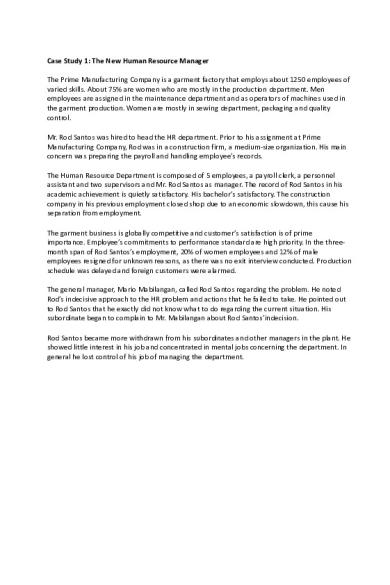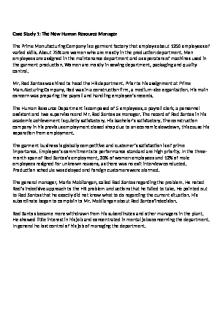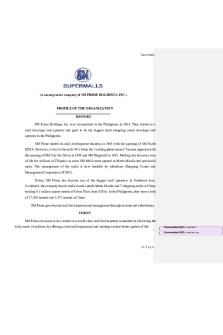Case Study 1 The New Human Resource Mana PDF

| Title | Case Study 1 The New Human Resource Mana |
|---|---|
| Author | rashmi M |
| Course | Bachelor of engineering |
| Institution | Visvesvaraya Technological University |
| Pages | 6 |
| File Size | 66.6 KB |
| File Type | |
| Total Downloads | 264 |
| Total Views | 351 |
Summary
Download Case Study 1 The New Human Resource Mana PDF
Description
Case Study 1: The New Human Resource Manager The Prime Manufacturing Company is a garment factory that employs about 1250 employees of varied skills. About 75% are women who are mostly in the production department. Men employees are assigned in the maintenance department and as operators of machines used in the garment production. Women are mostly in sewing department, packaging and quality control. Mr. Rod Santos was hired to head the HR department. Prior to his assignment at Prime Manufacturing Company, Rod was in a construction firm, a medium-size organization. His main concern was preparing the payroll and handling employee’s records. The Human Resource Department is composed of 5 employees, a payroll clerk, a personnel assistant and two supervisors and Mr. Rod Santos as manager. The record of Rod Santos in his academic achievement is quietly satisfactory. His bachelor’s satisfactory. The construction company in his previous employment closed shop due to an economic slowdown, this cause his separation from employment. The garment business is globally competitive and customer’s satisfaction is of prime importance. Employee’s commitments to performance standard are high priority. In the threemonth span of Rod Santos’s employment, 20% of women employees and 12% of male employees resigned for unknown reasons, as there was no exit interview conducted. Production schedule was delayed and foreign customers were alarmed. The general manager, Mario Mabilangan, called Rod Santos regarding the problem. He noted Rod’s indecisive approach to the HR problem and actions that he failed to take. He pointed out to Rod Santos that he exactly did not know what to do regarding the current situation. His subordinate began to complain to Mr. Mabilangan about Rod Santos’indecision. Rod Santos became more withdrawn from his subordinates and other managers in the plant. He showed little interest in his job and concentrated in mental jobs concerning the department. In general he lost control of his job of managing the department.
Case Study 2: The Outsider Peter Movers Corporation was expanding its operation in its construction business and trading activities. Most of the employees come from technically trained manpower due to the nature of work. The management feel that they need to hire new and fresh executive to bief up the growing work force. A nontechnical executive in the person of Roger Santiago was added to the working teams of managers. He was assigned as assistant to the president and chief-executive officer. The work of Mr. Santiago covers analysis of manpower programs and cost related activities and to give advice to the president of some management aspects that are not generally handled by line managers. The appointment of Mr. Santiago was not received well by older managers. They felt that insider should have been placed instead as assistant to the president. Mr. Santiago had difficulty getting some important information from line managers, without the expressed orders from the president. Nevertheless, Mr. Santiago continued to prove his worth by instituting new work programs and managerial activities, that brought substantial improvement in the company operation and profitability. He worked for management compensation systems that gave more benefits and produced more dedicated manpower. He made a lot of improvements in system designed and work improvement programs. Five years later, Mr. Santiago was promoted to the position of vice president. During the period of proving his managerial competence, managerial employees slowly began to like him as a person worthy to the position. His promotion to the position was well received by all.
Case Study 3: Seniority in the Organization Permaja Resources Corporaton has the policy of promoting employess within the organization on a company wide basis. Seniority is based on the length of service and the performance ratings. Rod Santos was hired as a mechanical engineer trainee on March 20, 2002 and got a performance rating of very satisfactory. He was a trainee for 6 months before his promotion to Engineer at Section A of the machine shop section. Roger Santiago was hired in January 2003 as engineer trainee in Section B of the machine shop and had performance rating of very satisfactory for the last two years. Both Santos and Santiago are mechanical engineering graduates of a prestigious school. The position of supervising engineer in Section B left vacant with the promotion of Art Real to Plant Superintendent of both section A and B. due to the seniority rule, Rod Santos was promoted to the post. While Art would like to recommend Roger Santiago to the post, the HR department policy on seniority rule had to be applied, hence the intention watered down when he talked to the HR manager, Art talked to Rod Santos about this case and Rod Santos understood that Roger Santiago was also interested in the position. One month later, a major machine broke down and Roger Santiago single-handedly worked diligently on the machine and completed it in due time to meet the customers demand. During a break time after the successful repair of the machine, Rod Santos in the presence of the other workers, complemented the efforts and expertise of Roger Santiago. “Roger, thanks for the excellent work you have done. You are the best engineer around here and I would like you to know that I appreciate very much your effort. You have the knowledge, skills ad experience around here and you are the number one engineer along this line” With the compliment, Roger Santiago retorted a little sarcastically “I know how all these things run here as I am one of those who installed that machine. I know more about this whole thing than you do. If only the HR department knew how to recognize people with potential, you would not be here n the first place”
Case Study 4: The Case of Mr. Pedro Dela Cruz Mr. Pedro Dela Cruz was strongly recommended by Mayor Punongbayan to work at the ABC Company located in the municipality. Mr. Dela Cruz was a new graduate of management of the local municipal university where the mayor himself as the President. His transcripts of records reveal that he is an average student and had no extracurricular activity in school. His father happens to be the supporter of the mayor in his political career. Mr. Dela Cruz took the examination given by the company and he failed to make it due to his poor communication skills. To give in to the mayor’s request, the human resource manager gave him a position in the production department as machine operator and not a clerical position that the mayor would like him to have. But Mr. Dela Cruz did not want to accept the position and insisted that he should get the job because of the mayor’s recommendation.
Case Study 5: The ABC Training Program The ABC Corporation has been engaged in the manufacture of electronic components for automobiles for the last 5 years. The company employs 350 employees and about 30 supervisors and managers. The increase in technology requires that employees be sent to training to cope with the increasing demand for updated new products consistent with the demand of local and foreign customers. The HR Manager suggested that here of the managers and eight supervisors be sent to the mother company in Japan for updates in technology on car electronics. The vice president for finance and the operation manager opposed the recommendation on the basis of cost-cutting and lack of personnel to handle the operations while they were away for two months. They suggested that technicians from the mother company be invited instead to handle the training in the Philippines. The cost of training by the mother company would double the cost of training as they are paid higher allowances and salaries that will be changed to the local company.
Case Study 6: Job Evaluation for Managerial Positions
The chairman of the board of directors of Jonadel Corporation has proposed that all managerial positions be included in the corporate job evaluation program. The idea came from several friends in other companies of the Chamber of Commerce and Industries where he is a member of the board of directors. The inclusion of the managerial positions in other company's job evaluation program has been found successful and helpful. There are differences in the pay systems based on the job evaluation in these companies and the chairman is convinced that these will work also with the company where the chairman is and has the greatest shares of stocks. In one of the special meetings of the Board of Directors, he proposed the idea to the chief operating officer. The chief operating officer said that the programs be held in abeyance until he had consulted his line and operating managers who will be affected by the changes due to the job evaluation system that will be implemented. In the meeting called by the chief operating officer, most of the managers opposed the idea. They argued that their positions cannot be with other positions due to the complexity of their responsibilities. They pointed out further to the CEO that no job evaluators can possibly know the extent of their jobs and compare the same with subordinate positions. The objections of the managers were that the qualities for such positions were varied and salaries were differently structured based on experience and length of service in the company. The CEO while being neutral, feared that if the job evaluation would include the positions of his line and operating managers, he would be losing his best people in the organization. He also thought that developing new manager takes time and those operations might suffer due to changes in the organizational system. The Human Resource Manager in his talk with the chairman of the board was in favor of the idea. He discussed the same with his staff and also supported the ides of including the managerial positions. The CEO called the president to prepare a memorandum for the Human Resource Department to study the program and implement the Job Evaluation. Program for managerial positions. The Program should give details of the advantages of the program and the process of what is to be done and how it should be done....
Similar Free PDFs

Human Resource Management Case Study
- 14 Pages

Human Resource Study Material
- 39 Pages

ASM 3 Human Resouces Mana
- 11 Pages
Popular Institutions
- Tinajero National High School - Annex
- Politeknik Caltex Riau
- Yokohama City University
- SGT University
- University of Al-Qadisiyah
- Divine Word College of Vigan
- Techniek College Rotterdam
- Universidade de Santiago
- Universiti Teknologi MARA Cawangan Johor Kampus Pasir Gudang
- Poltekkes Kemenkes Yogyakarta
- Baguio City National High School
- Colegio san marcos
- preparatoria uno
- Centro de Bachillerato Tecnológico Industrial y de Servicios No. 107
- Dalian Maritime University
- Quang Trung Secondary School
- Colegio Tecnológico en Informática
- Corporación Regional de Educación Superior
- Grupo CEDVA
- Dar Al Uloom University
- Centro de Estudios Preuniversitarios de la Universidad Nacional de Ingeniería
- 上智大学
- Aakash International School, Nuna Majara
- San Felipe Neri Catholic School
- Kang Chiao International School - New Taipei City
- Misamis Occidental National High School
- Institución Educativa Escuela Normal Juan Ladrilleros
- Kolehiyo ng Pantukan
- Batanes State College
- Instituto Continental
- Sekolah Menengah Kejuruan Kesehatan Kaltara (Tarakan)
- Colegio de La Inmaculada Concepcion - Cebu












